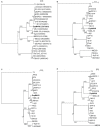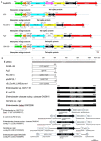Characterization and Genome Structure of Virulent Phage EspM4VN to Control Enterobacter sp. M4 Isolated From Plant Soft Rot
- PMID: 32582040
- PMCID: PMC7283392
- DOI: 10.3389/fmicb.2020.00885
Characterization and Genome Structure of Virulent Phage EspM4VN to Control Enterobacter sp. M4 Isolated From Plant Soft Rot
Abstract
Enterobacter sp. M4 and other bacterial strains were isolated from plant soft rot disease. Virulent phages such as EspM4VN isolated from soil are trending biological controls for plant disease. This phage has an icosahedral head (100 nm in diameter), a neck, and a contractile sheath (100 nm long and 18 nm wide). It belongs to the Ackermannviridae family and resembles Shigella phage Ag3 and Dickeya phages JA15 and XF4. We report herein that EspM4VN was stable from 10°C to 50°C and pH 4 to 10 but deactivated at 70°C and pH 3 and 12. This phage formed clear plaques only on Enterobacter sp. M4 among tested bacterial strains. A one-step growth curve showed that the latent phase was 20 min, rise period was 10 min, and an average of 122 phage particles were released from each absorbed cell. We found the phage's genome size was 160,766 bp and that it annotated 219 open reading frames. The genome organization of EspM4VN has high similarity with the Salmonella phage SKML-39; Dickeya phages Coodle, PP35, JA15, and Limestone; and Shigella phage Ag3. The phage EspM4VN has five tRNA species, four tail-spike proteins, and a thymidylate synthase. Phylogenetic analysis based on structural proteins and enzymes indicated that EspM4VN was identified as a member of the genus Agtrevirus, subfamily Aglimvirinae, family Ackermannviridae.
Keywords: Agtrevirus; Enterobacter; genome; soft rot disease; virulent phage.
Copyright © 2020 Thanh, Nagayoshi, Fujino, Iiyama, Furuya, Hiromasa, Iwamoto and Doi.
Figures








Similar articles
-
Renewed insights into Ackermannviridae phage biology and applications.Npj Viruses. 2024 Aug 21;2(1):37. doi: 10.1038/s44298-024-00046-0. Npj Viruses. 2024. PMID: 40295767 Free PMC article. Review.
-
Two New Dickeya dadantii Phages with Odd Growth Patterns Expand the Diversity of Phages Infecting Soft Rot Pectobacteriaceae.Phage (New Rochelle). 2020 Dec 1;1(4):251-259. doi: 10.1089/phage.2020.0039. Epub 2020 Dec 16. Phage (New Rochelle). 2020. PMID: 36147281 Free PMC article.
-
Host Specificity of the Dickeya Bacteriophage PP35 Is Directed by a Tail Spike Interaction With Bacterial O-Antigen, Enabling the Infection of Alternative Non-pathogenic Bacterial Host.Front Microbiol. 2019 Jan 11;9:3288. doi: 10.3389/fmicb.2018.03288. eCollection 2018. Front Microbiol. 2019. PMID: 30687274 Free PMC article.
-
Isolation, characterization and biocontrol efficacy of a T4-like phage virulent to multidrug-resistant Enterobacter hormaechei.Dis Aquat Organ. 2021 Dec 16;147:97-109. doi: 10.3354/dao03622. Dis Aquat Organ. 2021. PMID: 34913439
-
Isolation and Characterization of Shewanella Phage Thanatos Infecting and Lysing Shewanella oneidensis and Promoting Nascent Biofilm Formation.Front Microbiol. 2020 Sep 18;11:573260. doi: 10.3389/fmicb.2020.573260. eCollection 2020. Front Microbiol. 2020. PMID: 33072035 Free PMC article.
Cited by
-
Subtypes of tail spike proteins predicts the host range of Ackermannviridae phages.Comput Struct Biotechnol J. 2021 Aug 21;19:4854-4867. doi: 10.1016/j.csbj.2021.08.030. eCollection 2021. Comput Struct Biotechnol J. 2021. PMID: 34527194 Free PMC article.
-
Genomic and Proteomic Analysis of Six Vi01-like Phages Reveals Wide Host Range and Multiple Tail Spike Proteins.Viruses. 2024 Feb 13;16(2):289. doi: 10.3390/v16020289. Viruses. 2024. PMID: 38400064 Free PMC article.
-
Tailoring the Host Range of Ackermannviridae Bacteriophages through Chimeric Tailspike Proteins.Viruses. 2023 Jan 19;15(2):286. doi: 10.3390/v15020286. Viruses. 2023. PMID: 36851500 Free PMC article.
-
Isolation of a bacteriophage targeting Pseudomonas aeruginosa and exhibits a promising in vivo efficacy.AMB Express. 2023 Jul 26;13(1):79. doi: 10.1186/s13568-023-01582-3. AMB Express. 2023. PMID: 37495819 Free PMC article.
-
Renewed insights into Ackermannviridae phage biology and applications.Npj Viruses. 2024 Aug 21;2(1):37. doi: 10.1038/s44298-024-00046-0. Npj Viruses. 2024. PMID: 40295767 Free PMC article. Review.
References
-
- Adams M. H. (1959). Bacteriophages. New York, NY: Interscience Publishers Inc.
-
- Adeolu M., Alnajar S., Naushad S., Gupta R. S. (2016). Genome-based phylogeny and taxonomy of the ‘Enterobacteriales’: proposal for Enterobacterales ord. nov. divided into the families Enterobacteriaceae, Erwiniaceae fam. nov., Pectobacteriaceae fam. nov., Yersiniaceae fam. nov., Hafniaceae fam. nov., Morganellaceae fam. nov., and Budviciaceae fam. nov. Int. J. Syst. Evol. Microbiol. 66 5575–5599. 10.1099/ijsem.0.001485 - DOI - PubMed
LinkOut - more resources
Full Text Sources
Molecular Biology Databases

